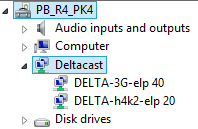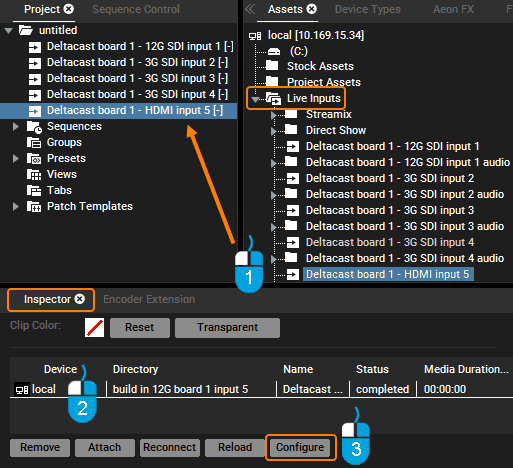Loading...
This chapter describes the optional HDMI input card. For other input or output boards, please see the introductory chapter.
|
There is one HDMI 2.0 card available with two inputs (HDMI Type A). The card is shipped with a DisplayPort-HDMI adapter. The card allows to input HDMI (or DisplayPort or DVI) signals to be used within the Pandoras Box render engine. |
The HDMI 2.0 capture card supports on both inputs simultaneously any HDMI format, including 4K @ 60Hz with a color depth of 24bit/px. Since Pandoras Box version 6.4.0 you can choose another chroma sub sampling when working with HDMI inputs, i.e. RGB 4:4.4, in addition to YUV 4:2:2. You can find this option in the configuration window from the input.
You can also use the HDMI input for a DisplayPort signal, an adapter is included. Note that HDMI is also backward compatible with DVI (single-link DVI-D, but not DVI-A). It is possible to use DVI to HDMI adapters and keeping the video quality as no signal conversion is required.
Please note that HDCP-protected signals can not be processed!
As for the audio formats, de-embedding of up to 8 channels (displayed as four stereo channels in the Assets tab) is possible when using Pandoras Box version 6.5 or higher. To playback the audio part on an Audio Track you always have to play the video part on a Video Layer simultaneously. Sample rates of 44.1k and 48k are supported. As Inputs are not resampled please make sure that the audio device matches this sample rate (Configuration tab > ASIO Audio). The sample rate of the HDMI audio channel is displayed in the Inspector when selecting it in the Project tab.
Dual HDMI input card |
|
|---|---|
HDMI |
This is a list of the maximum framerate for some standard 16:9 formats:
Frame rates from 23.98Hz to 120Hz depending on formats |

Starting with Pandoras Box version 6.4.1 we are supporting the original Deltacast drivers (version 6.14) which we have added to our driver package in the Download-Center.
The 12G-SDI board can only be used with driver version 6.14 (or later).
The DVI board (and old HD-SDI board) can only be used with driver version up to 6.01.
The 3G-SDI board and HDMI board can be used with both versions.
When having two or more cards in a single computer they have to run with the same driver version. Therefore, a DVI board cannot be used along with the 12G board in a single computer. Using different driver version on separate machines is not a problem.
The picture shows the "Deltacast" folder in the Windows Device Manager after installing a 3G-SDI and HDMI card using the Deltacast driver.
Video Inputs in Pandoras Box are managed by the Pandoras Box Manager, that is responsible for the entire show control. Only if you use the Manager in stand-alone mode, you would connect the video device to the Manager's input board. In case you work in a Manager-Client-setup and you want to use the stream on a Client, the Client must be equipped with an input board (not the Manager). In other words, the physical signal input happens on the same machine which should render and output the image. The video stream only "exists" on the Client, it is not distributed to the Manager nor to another Client. If you would like to display the stream on several Clients, all of them must be connected to the video source.
Follow this step-by-step description after having connected the video source to the input card:
- Start the Manager computer and Pandoras Box in Manager mode. If the input card is in the Client, start there the Client mode from the same version.
- then go to the Manager, Asset tab > local or Client > folder "Live Inputs"
- drag the according card into the Project tab; this initializes the card
- if you would like to change the chroma subsampling for the HDMI input, select it in the Project tab to display its properties in the Inspector. Scroll down in the Inspector to see the file table where you can select the live input and click the "Configure" button below (the below image shows the inputs from a 12G card)
- assign the live input to a layer in the Device Tree the same way as using common image or video files
Bear in mind that it is recommended to leave the signal source connected and not change any settings regarding the signal once Pandoras Box is started. Otherwise you might need to re-configure the input in Pandoras Box which requires to toggle the fullscreen window on a Client.
It is also possible to record the incoming signal. However, the Client computer must then be started in stand-alone mode, that is with the Pandoras Box Manager software. Please see the chapter "Audio and Video Recording" for more information.
